Analysis of Motivation, Trust, and Control in Management Principles
VerifiedAdded on 2023/06/10
|7
|1837
|477
Essay
AI Summary
This essay delves into several core management principles, starting with suggestions for motivating employees, including career path development, recognition, and constructive feedback. It emphasizes the critical role of trust in leadership, defining it through openness, loyalty, consistency, int...
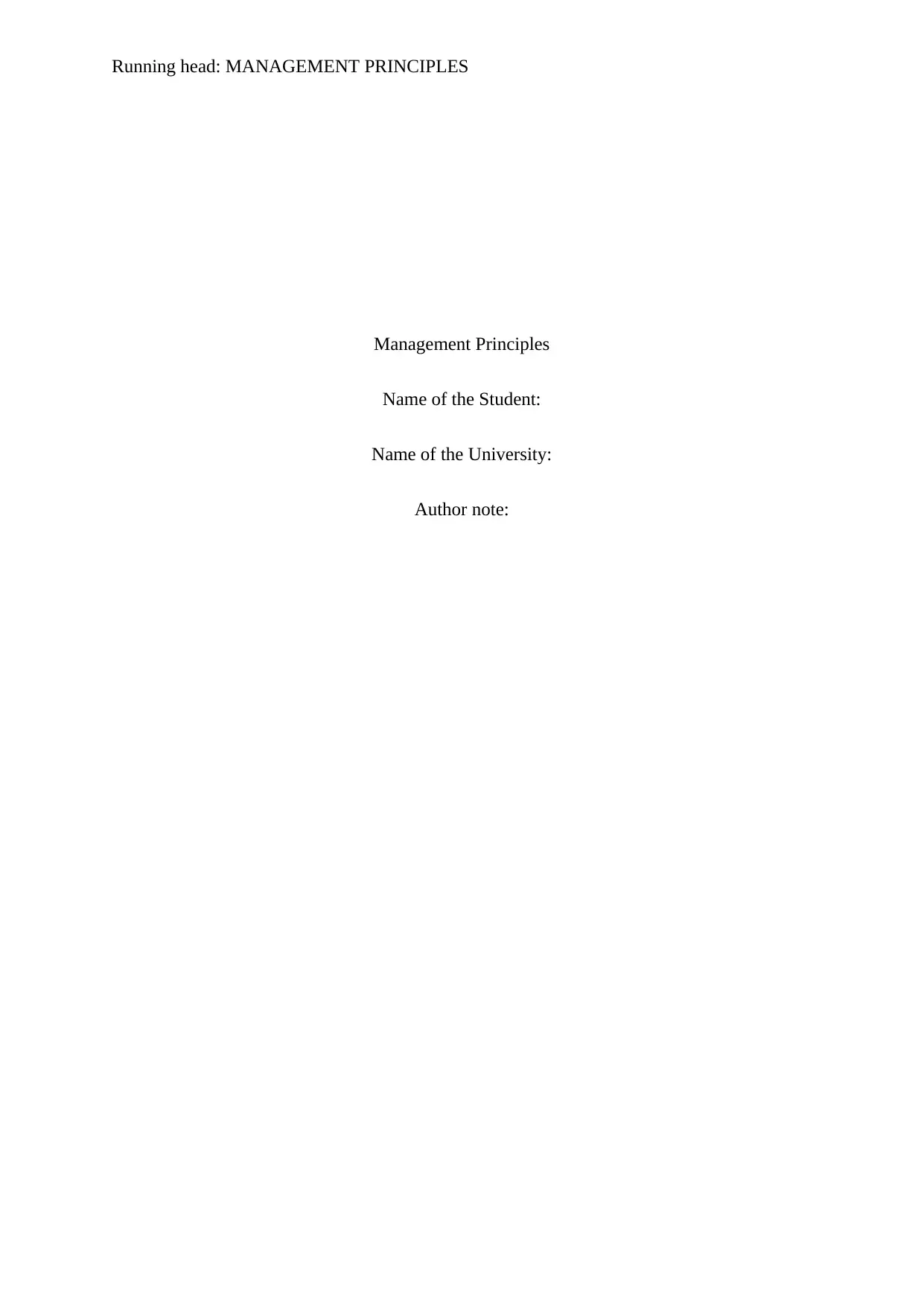
Running head: MANAGEMENT PRINCIPLES
Management Principles
Name of the Student:
Name of the University:
Author note:
Management Principles
Name of the Student:
Name of the University:
Author note:
Paraphrase This Document
Need a fresh take? Get an instant paraphrase of this document with our AI Paraphraser
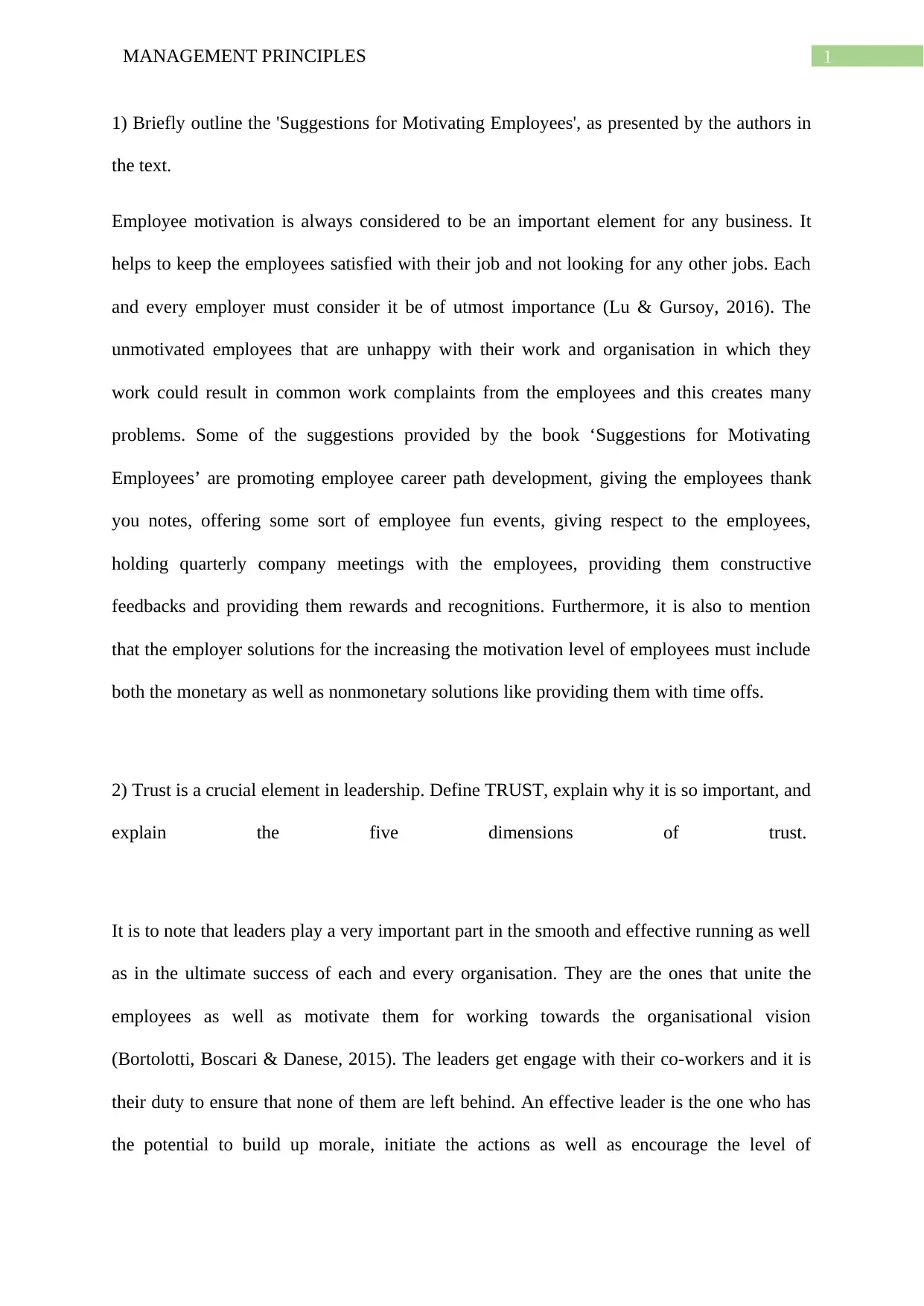
1MANAGEMENT PRINCIPLES
1) Briefly outline the 'Suggestions for Motivating Employees', as presented by the authors in
the text.
Employee motivation is always considered to be an important element for any business. It
helps to keep the employees satisfied with their job and not looking for any other jobs. Each
and every employer must consider it be of utmost importance (Lu & Gursoy, 2016). The
unmotivated employees that are unhappy with their work and organisation in which they
work could result in common work complaints from the employees and this creates many
problems. Some of the suggestions provided by the book ‘Suggestions for Motivating
Employees’ are promoting employee career path development, giving the employees thank
you notes, offering some sort of employee fun events, giving respect to the employees,
holding quarterly company meetings with the employees, providing them constructive
feedbacks and providing them rewards and recognitions. Furthermore, it is also to mention
that the employer solutions for the increasing the motivation level of employees must include
both the monetary as well as nonmonetary solutions like providing them with time offs.
2) Trust is a crucial element in leadership. Define TRUST, explain why it is so important, and
explain the five dimensions of trust.
It is to note that leaders play a very important part in the smooth and effective running as well
as in the ultimate success of each and every organisation. They are the ones that unite the
employees as well as motivate them for working towards the organisational vision
(Bortolotti, Boscari & Danese, 2015). The leaders get engage with their co-workers and it is
their duty to ensure that none of them are left behind. An effective leader is the one who has
the potential to build up morale, initiate the actions as well as encourage the level of
1) Briefly outline the 'Suggestions for Motivating Employees', as presented by the authors in
the text.
Employee motivation is always considered to be an important element for any business. It
helps to keep the employees satisfied with their job and not looking for any other jobs. Each
and every employer must consider it be of utmost importance (Lu & Gursoy, 2016). The
unmotivated employees that are unhappy with their work and organisation in which they
work could result in common work complaints from the employees and this creates many
problems. Some of the suggestions provided by the book ‘Suggestions for Motivating
Employees’ are promoting employee career path development, giving the employees thank
you notes, offering some sort of employee fun events, giving respect to the employees,
holding quarterly company meetings with the employees, providing them constructive
feedbacks and providing them rewards and recognitions. Furthermore, it is also to mention
that the employer solutions for the increasing the motivation level of employees must include
both the monetary as well as nonmonetary solutions like providing them with time offs.
2) Trust is a crucial element in leadership. Define TRUST, explain why it is so important, and
explain the five dimensions of trust.
It is to note that leaders play a very important part in the smooth and effective running as well
as in the ultimate success of each and every organisation. They are the ones that unite the
employees as well as motivate them for working towards the organisational vision
(Bortolotti, Boscari & Danese, 2015). The leaders get engage with their co-workers and it is
their duty to ensure that none of them are left behind. An effective leader is the one who has
the potential to build up morale, initiate the actions as well as encourage the level of
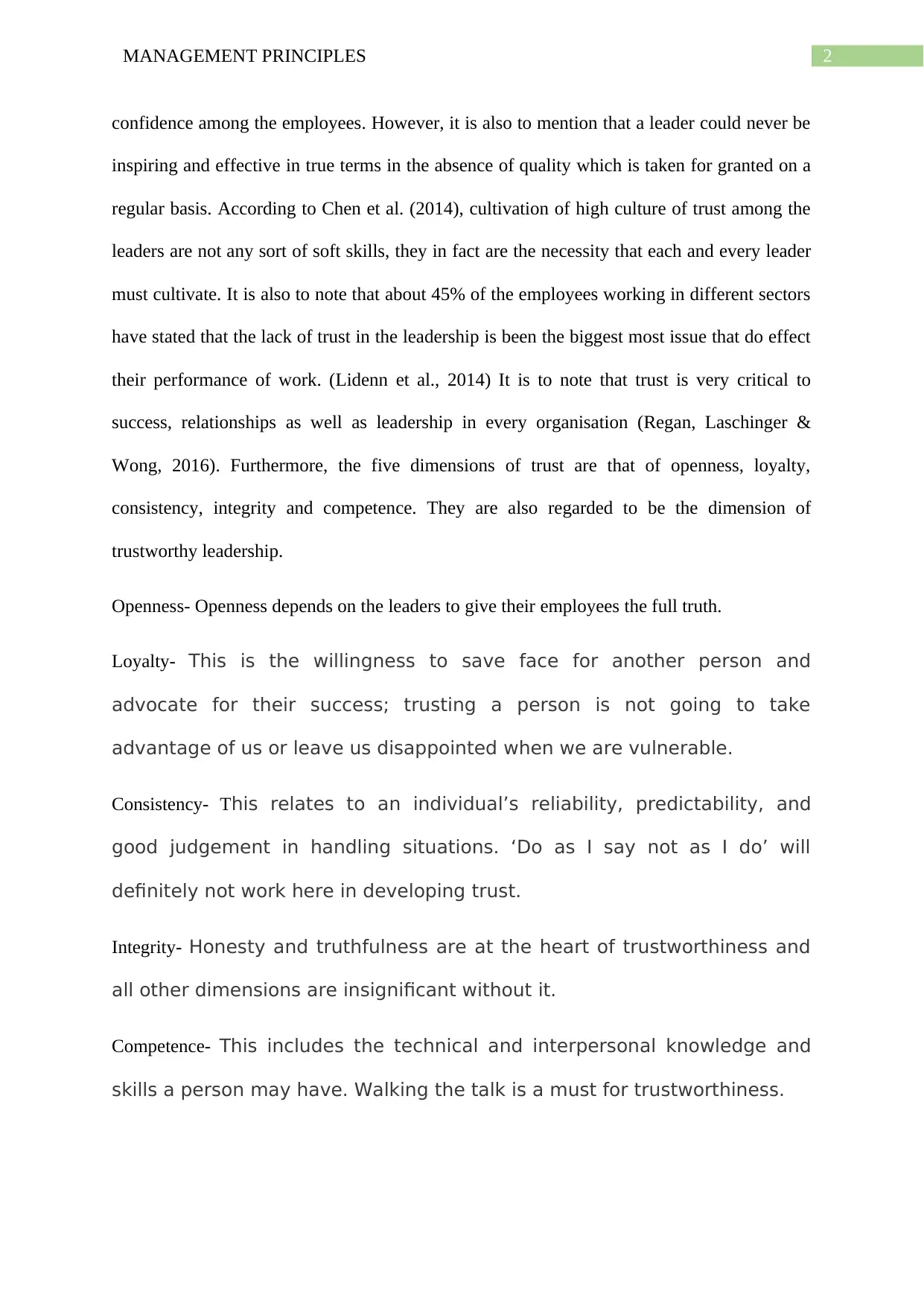
2MANAGEMENT PRINCIPLES
confidence among the employees. However, it is also to mention that a leader could never be
inspiring and effective in true terms in the absence of quality which is taken for granted on a
regular basis. According to Chen et al. (2014), cultivation of high culture of trust among the
leaders are not any sort of soft skills, they in fact are the necessity that each and every leader
must cultivate. It is also to note that about 45% of the employees working in different sectors
have stated that the lack of trust in the leadership is been the biggest most issue that do effect
their performance of work. (Lidenn et al., 2014) It is to note that trust is very critical to
success, relationships as well as leadership in every organisation (Regan, Laschinger &
Wong, 2016). Furthermore, the five dimensions of trust are that of openness, loyalty,
consistency, integrity and competence. They are also regarded to be the dimension of
trustworthy leadership.
Openness- Openness depends on the leaders to give their employees the full truth.
Loyalty- This is the willingness to save face for another person and
advocate for their success; trusting a person is not going to take
advantage of us or leave us disappointed when we are vulnerable.
Consistency- This relates to an individual’s reliability, predictability, and
good judgement in handling situations. ‘Do as I say not as I do’ will
definitely not work here in developing trust.
Integrity- Honesty and truthfulness are at the heart of trustworthiness and
all other dimensions are insignificant without it.
Competence- This includes the technical and interpersonal knowledge and
skills a person may have. Walking the talk is a must for trustworthiness.
confidence among the employees. However, it is also to mention that a leader could never be
inspiring and effective in true terms in the absence of quality which is taken for granted on a
regular basis. According to Chen et al. (2014), cultivation of high culture of trust among the
leaders are not any sort of soft skills, they in fact are the necessity that each and every leader
must cultivate. It is also to note that about 45% of the employees working in different sectors
have stated that the lack of trust in the leadership is been the biggest most issue that do effect
their performance of work. (Lidenn et al., 2014) It is to note that trust is very critical to
success, relationships as well as leadership in every organisation (Regan, Laschinger &
Wong, 2016). Furthermore, the five dimensions of trust are that of openness, loyalty,
consistency, integrity and competence. They are also regarded to be the dimension of
trustworthy leadership.
Openness- Openness depends on the leaders to give their employees the full truth.
Loyalty- This is the willingness to save face for another person and
advocate for their success; trusting a person is not going to take
advantage of us or leave us disappointed when we are vulnerable.
Consistency- This relates to an individual’s reliability, predictability, and
good judgement in handling situations. ‘Do as I say not as I do’ will
definitely not work here in developing trust.
Integrity- Honesty and truthfulness are at the heart of trustworthiness and
all other dimensions are insignificant without it.
Competence- This includes the technical and interpersonal knowledge and
skills a person may have. Walking the talk is a must for trustworthiness.
⊘ This is a preview!⊘
Do you want full access?
Subscribe today to unlock all pages.

Trusted by 1+ million students worldwide
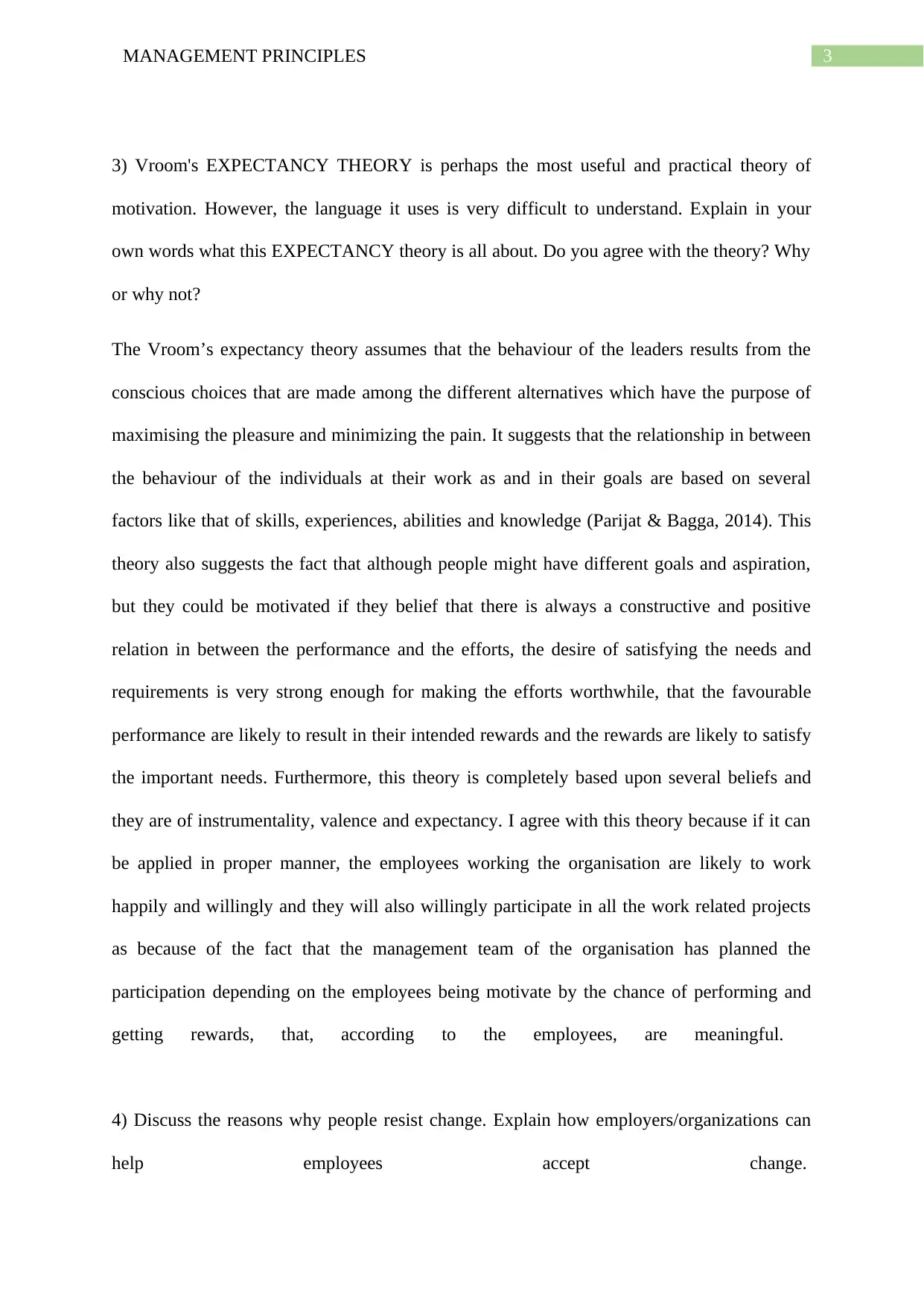
3MANAGEMENT PRINCIPLES
3) Vroom's EXPECTANCY THEORY is perhaps the most useful and practical theory of
motivation. However, the language it uses is very difficult to understand. Explain in your
own words what this EXPECTANCY theory is all about. Do you agree with the theory? Why
or why not?
The Vroom’s expectancy theory assumes that the behaviour of the leaders results from the
conscious choices that are made among the different alternatives which have the purpose of
maximising the pleasure and minimizing the pain. It suggests that the relationship in between
the behaviour of the individuals at their work as and in their goals are based on several
factors like that of skills, experiences, abilities and knowledge (Parijat & Bagga, 2014). This
theory also suggests the fact that although people might have different goals and aspiration,
but they could be motivated if they belief that there is always a constructive and positive
relation in between the performance and the efforts, the desire of satisfying the needs and
requirements is very strong enough for making the efforts worthwhile, that the favourable
performance are likely to result in their intended rewards and the rewards are likely to satisfy
the important needs. Furthermore, this theory is completely based upon several beliefs and
they are of instrumentality, valence and expectancy. I agree with this theory because if it can
be applied in proper manner, the employees working the organisation are likely to work
happily and willingly and they will also willingly participate in all the work related projects
as because of the fact that the management team of the organisation has planned the
participation depending on the employees being motivate by the chance of performing and
getting rewards, that, according to the employees, are meaningful.
4) Discuss the reasons why people resist change. Explain how employers/organizations can
help employees accept change.
3) Vroom's EXPECTANCY THEORY is perhaps the most useful and practical theory of
motivation. However, the language it uses is very difficult to understand. Explain in your
own words what this EXPECTANCY theory is all about. Do you agree with the theory? Why
or why not?
The Vroom’s expectancy theory assumes that the behaviour of the leaders results from the
conscious choices that are made among the different alternatives which have the purpose of
maximising the pleasure and minimizing the pain. It suggests that the relationship in between
the behaviour of the individuals at their work as and in their goals are based on several
factors like that of skills, experiences, abilities and knowledge (Parijat & Bagga, 2014). This
theory also suggests the fact that although people might have different goals and aspiration,
but they could be motivated if they belief that there is always a constructive and positive
relation in between the performance and the efforts, the desire of satisfying the needs and
requirements is very strong enough for making the efforts worthwhile, that the favourable
performance are likely to result in their intended rewards and the rewards are likely to satisfy
the important needs. Furthermore, this theory is completely based upon several beliefs and
they are of instrumentality, valence and expectancy. I agree with this theory because if it can
be applied in proper manner, the employees working the organisation are likely to work
happily and willingly and they will also willingly participate in all the work related projects
as because of the fact that the management team of the organisation has planned the
participation depending on the employees being motivate by the chance of performing and
getting rewards, that, according to the employees, are meaningful.
4) Discuss the reasons why people resist change. Explain how employers/organizations can
help employees accept change.
Paraphrase This Document
Need a fresh take? Get an instant paraphrase of this document with our AI Paraphraser

4MANAGEMENT PRINCIPLES
- Expecting the resistance to change as well as planning for it from the very beginning of the
change management programs often allows people to effectively manage the objections.
However, it is often seen that people resist change and this can be due to several different
perspectives of theirs and for several different reasons. The first is that there can be often
seen some sort of misunderstanding about the needs for the change when it is not clear for the
employees that why the change is taking place in the first place (Canning & Found, 2015).
This is a vital reason to consider due to the fact that if the employees do not get a clear
understanding about the need for change then they are likely to resist it. This is particularly
done by the ones who thinks that the prevailing way of doing the things are working well.
5) Outline and explain the types of control presented in the chapter on Foundations of
Control.
In the chapter Foundation of Control, the process of control refers to a three-step process of
measuring the actual performance, taking the managerial actions for correcting the
deviations, addressing the sufficient standards and comparing the true performance against
the standard. However, the types of control mentioned in this chapter are feed forward
control, feedback control and concurrent control (Borman, 2017). The feedback control takes
place after the very activity is done. In this type of control, the problems might already take
place and have already caused some sort of waste or damage. It is considered to be the
popular type of control. It has two advantaged and they are- it can enhance the motivation
level of the employees and provide a meaningful information on the planning effectiveness.
The feed forward control on the other hand helps in preventing the anticipated issues and it is
one of the most desirable control (Sinclair et al., 2014). However, it needs accurate and
timely information which often is very difficult to achieve. Lastly, the concurrent control
happens when the activity are in progress. They corrects the issues prior to its conversion to
very costly. Also, it is one of the best known form of control.
- Expecting the resistance to change as well as planning for it from the very beginning of the
change management programs often allows people to effectively manage the objections.
However, it is often seen that people resist change and this can be due to several different
perspectives of theirs and for several different reasons. The first is that there can be often
seen some sort of misunderstanding about the needs for the change when it is not clear for the
employees that why the change is taking place in the first place (Canning & Found, 2015).
This is a vital reason to consider due to the fact that if the employees do not get a clear
understanding about the need for change then they are likely to resist it. This is particularly
done by the ones who thinks that the prevailing way of doing the things are working well.
5) Outline and explain the types of control presented in the chapter on Foundations of
Control.
In the chapter Foundation of Control, the process of control refers to a three-step process of
measuring the actual performance, taking the managerial actions for correcting the
deviations, addressing the sufficient standards and comparing the true performance against
the standard. However, the types of control mentioned in this chapter are feed forward
control, feedback control and concurrent control (Borman, 2017). The feedback control takes
place after the very activity is done. In this type of control, the problems might already take
place and have already caused some sort of waste or damage. It is considered to be the
popular type of control. It has two advantaged and they are- it can enhance the motivation
level of the employees and provide a meaningful information on the planning effectiveness.
The feed forward control on the other hand helps in preventing the anticipated issues and it is
one of the most desirable control (Sinclair et al., 2014). However, it needs accurate and
timely information which often is very difficult to achieve. Lastly, the concurrent control
happens when the activity are in progress. They corrects the issues prior to its conversion to
very costly. Also, it is one of the best known form of control.
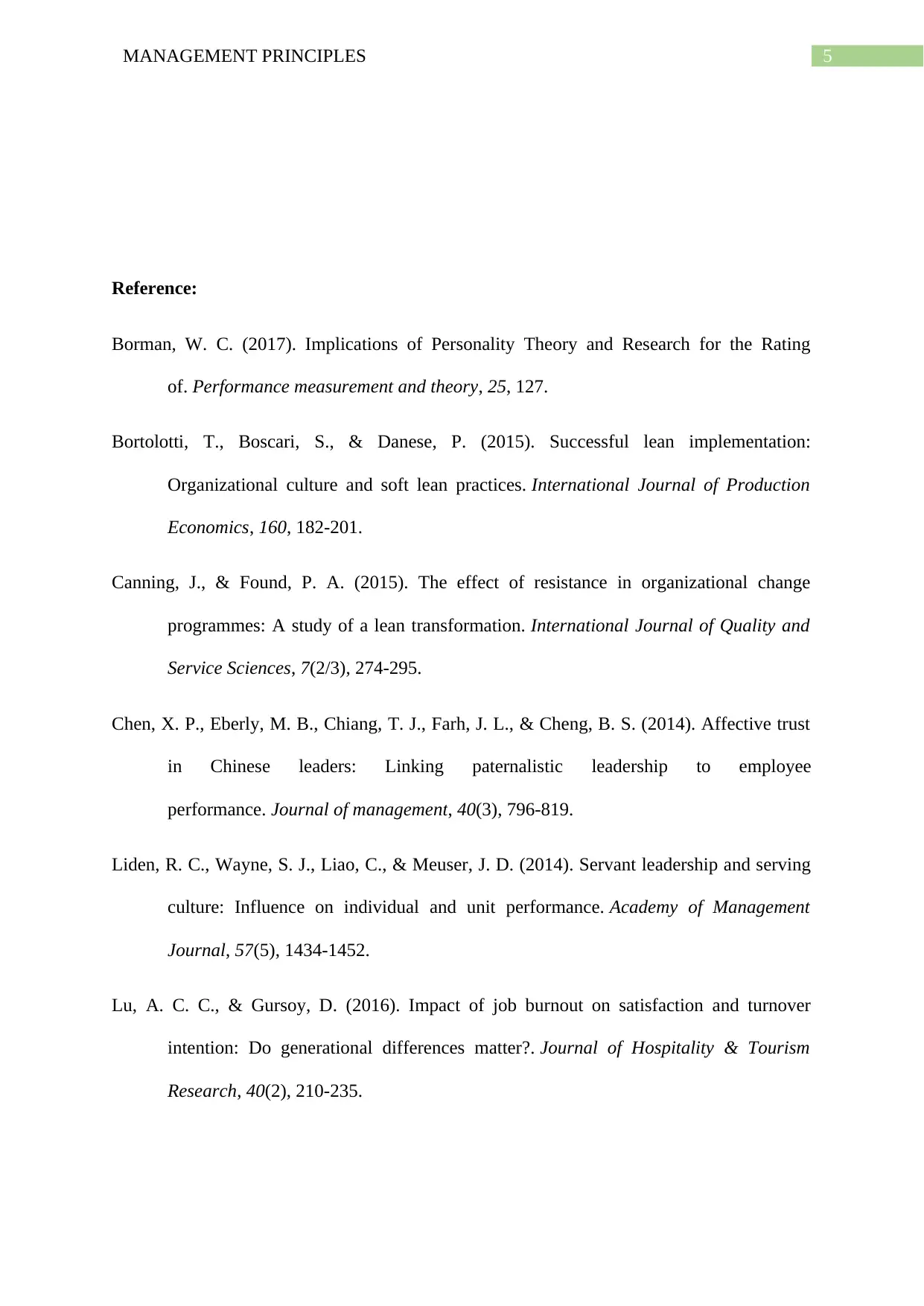
5MANAGEMENT PRINCIPLES
Reference:
Borman, W. C. (2017). Implications of Personality Theory and Research for the Rating
of. Performance measurement and theory, 25, 127.
Bortolotti, T., Boscari, S., & Danese, P. (2015). Successful lean implementation:
Organizational culture and soft lean practices. International Journal of Production
Economics, 160, 182-201.
Canning, J., & Found, P. A. (2015). The effect of resistance in organizational change
programmes: A study of a lean transformation. International Journal of Quality and
Service Sciences, 7(2/3), 274-295.
Chen, X. P., Eberly, M. B., Chiang, T. J., Farh, J. L., & Cheng, B. S. (2014). Affective trust
in Chinese leaders: Linking paternalistic leadership to employee
performance. Journal of management, 40(3), 796-819.
Liden, R. C., Wayne, S. J., Liao, C., & Meuser, J. D. (2014). Servant leadership and serving
culture: Influence on individual and unit performance. Academy of Management
Journal, 57(5), 1434-1452.
Lu, A. C. C., & Gursoy, D. (2016). Impact of job burnout on satisfaction and turnover
intention: Do generational differences matter?. Journal of Hospitality & Tourism
Research, 40(2), 210-235.
Reference:
Borman, W. C. (2017). Implications of Personality Theory and Research for the Rating
of. Performance measurement and theory, 25, 127.
Bortolotti, T., Boscari, S., & Danese, P. (2015). Successful lean implementation:
Organizational culture and soft lean practices. International Journal of Production
Economics, 160, 182-201.
Canning, J., & Found, P. A. (2015). The effect of resistance in organizational change
programmes: A study of a lean transformation. International Journal of Quality and
Service Sciences, 7(2/3), 274-295.
Chen, X. P., Eberly, M. B., Chiang, T. J., Farh, J. L., & Cheng, B. S. (2014). Affective trust
in Chinese leaders: Linking paternalistic leadership to employee
performance. Journal of management, 40(3), 796-819.
Liden, R. C., Wayne, S. J., Liao, C., & Meuser, J. D. (2014). Servant leadership and serving
culture: Influence on individual and unit performance. Academy of Management
Journal, 57(5), 1434-1452.
Lu, A. C. C., & Gursoy, D. (2016). Impact of job burnout on satisfaction and turnover
intention: Do generational differences matter?. Journal of Hospitality & Tourism
Research, 40(2), 210-235.
⊘ This is a preview!⊘
Do you want full access?
Subscribe today to unlock all pages.

Trusted by 1+ million students worldwide
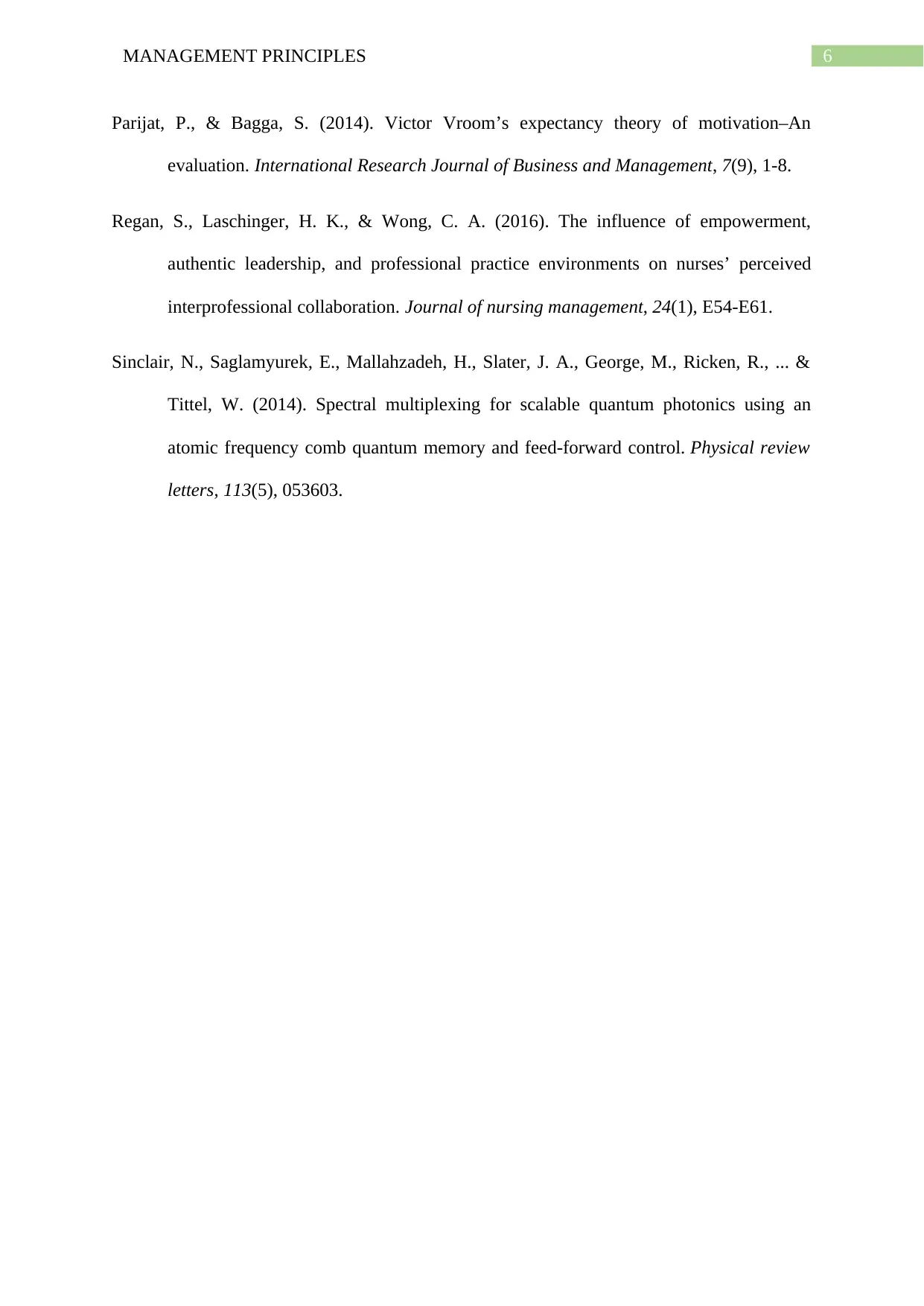
6MANAGEMENT PRINCIPLES
Parijat, P., & Bagga, S. (2014). Victor Vroom’s expectancy theory of motivation–An
evaluation. International Research Journal of Business and Management, 7(9), 1-8.
Regan, S., Laschinger, H. K., & Wong, C. A. (2016). The influence of empowerment,
authentic leadership, and professional practice environments on nurses’ perceived
interprofessional collaboration. Journal of nursing management, 24(1), E54-E61.
Sinclair, N., Saglamyurek, E., Mallahzadeh, H., Slater, J. A., George, M., Ricken, R., ... &
Tittel, W. (2014). Spectral multiplexing for scalable quantum photonics using an
atomic frequency comb quantum memory and feed-forward control. Physical review
letters, 113(5), 053603.
Parijat, P., & Bagga, S. (2014). Victor Vroom’s expectancy theory of motivation–An
evaluation. International Research Journal of Business and Management, 7(9), 1-8.
Regan, S., Laschinger, H. K., & Wong, C. A. (2016). The influence of empowerment,
authentic leadership, and professional practice environments on nurses’ perceived
interprofessional collaboration. Journal of nursing management, 24(1), E54-E61.
Sinclair, N., Saglamyurek, E., Mallahzadeh, H., Slater, J. A., George, M., Ricken, R., ... &
Tittel, W. (2014). Spectral multiplexing for scalable quantum photonics using an
atomic frequency comb quantum memory and feed-forward control. Physical review
letters, 113(5), 053603.
1 out of 7
Related Documents
Your All-in-One AI-Powered Toolkit for Academic Success.
+13062052269
info@desklib.com
Available 24*7 on WhatsApp / Email
![[object Object]](/_next/static/media/star-bottom.7253800d.svg)
Unlock your academic potential
© 2024 | Zucol Services PVT LTD | All rights reserved.





